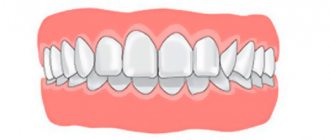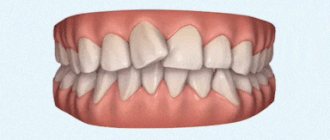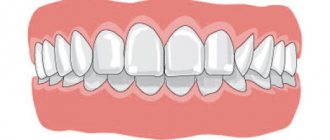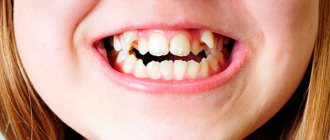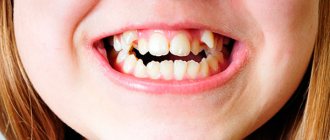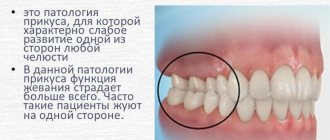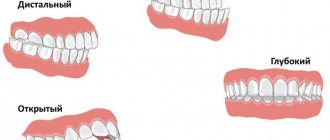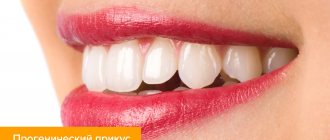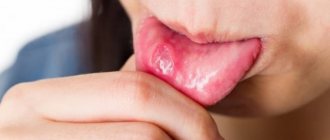Even, beautiful teeth attract the eye, but this is not enough for a dentist. According to doctors, it is necessary to have the correct bite, width, and healthy tissues of the teeth and gums. If a person’s smile is not ideal, you can use advances in dentistry that can eliminate almost any imperfections.
Dental correction is indicated if the patient:
- Interdental spaces;
- The dentition is uneven;
- There are curvatures;
- Unsightly pigmentation;
- Crowding
If there is a slight deviation, you can install veneers, crowns, or use restoration with composite materials. For significant defects, it is recommended to install braces.
Correction of position and curvature
For minor defects - crowding, uneven teeth, gaps between teeth - can be corrected with veneers or composite material. If significant correction of the bite is required, the patient is recommended to use braces. We offer patients several options for corrective systems, differing in the level of aesthetics, material and device. In the most difficult cases, surgical intervention is resorted to.
Types of malocclusion
- open - the teeth either do not close at all, or a significant gap is visible between many of them;
- deep – the exact opposite situation, that is, there is an overlap of approximately half the length;
- mesial – the lower jaw, compared to the upper, is moved forward;
- distal – the problem is the opposite of the previous one;
- cross - the right and left sides protrude unevenly, the cutting edges close together.
Other anomalies include:
- diastema - a gap between the front pair of incisors;
- three - noticeable gaps between “neighbors” along the gum;
- twisting - creeping of sixes, fours, fives onto each other;
- transposition - eruption in the wrong places, right up to the palate.
Any of them is not just inconvenient or bad from an aesthetic point of view, but can also provoke the emergence and development of a number of diseases. It develops against the background of genetic abnormalities and heredity, appears due to injuries and loss of bone tissue.
Teeth color correction
When creating the perfect smile, you often have to adjust the color of your teeth. You can use enamel whitening, install veneers or perform professional hygiene.
When are veneers used:
- When the crown darkens;
- When chipped;
- For yellowed teeth (tetracycline);
- If bleaching is ineffective;
- With high sensitivity of teeth;
- If, in addition to the previous problems, the teeth are crooked, since veneers and lumineers also change their shape.
What is dental restoration and is it worth doing?
In modern society, beautiful and healthy teeth are one of the main signs of high social status! Therefore, if you do not want to look like a loser who does not have the means to take care of your appearance and health, then immediately run to the dentist and ask him to get your teeth in order. Remember that neither expensive clothes, nor a beautiful hairstyle, nor high-quality makeup can compensate for the unpleasant impression of your gap-toothed smile and crooked, broken, yellow teeth!
From the article you will learn what restoration is and what methods you can most effectively restore your teeth to get the best smile in the world.
What is dental restoration?
Unlike conventional treatment, dental restoration involves only the aesthetic restoration of a damaged tooth. Simply put, you will not have your teeth removed and replaced with dentures or implants. The doctor will simply give your crooked or damaged teeth a beautiful appearance. Therefore, dental restoration can be called a cosmetic rather than a medical procedure.
What are the advantages and disadvantages of aesthetic dental restoration?
Like any cosmetic procedure, dental restoration has its advantages and disadvantages, which you can find below.
Advantages of dental restoration:
- No severe pain. Almost all procedures associated with dental restoration do not cause severe pain to the patient. Although, people with hypersensitive teeth may experience some discomfort.
- Speed of the process. In some cases, the restoration of one or more teeth requires only one visit to the dentist. Even if the restoration process requires several procedures, it lasts much less time than the process of dental prosthetics.
- Acceptable price. Almost all procedures for dental restoration are much cheaper than procedures for installing implants. But it is worth considering that the price largely depends on the level of the clinic and the city in which it is located.
Disadvantages of dental restoration:
- Lack of treatment. Restoration can improve the appearance of a tooth, but cannot cure it. For example, if there is inflammation in a tooth, it may remain after the restoration and cause pain to the patient. In addition, in some cases, it is better to remove the diseased tooth and install an implant, rather than mask it with restoration.
- Not very long guarantees. Restored teeth may become dull, change color and become damaged, especially if the patient is addicted to cigarettes, alcohol, sweets and eating hard foods. For this reason, dentists try not to give long-term guarantees on restored teeth.
For what defects should dental restoration be done?
As you already understand, dental restoration is recommended only if there are defects that do not require comprehensive treatment. Below you can find a list of these defects:
- The presence of caries on the surface of the teeth. After eliminating this defect, it is recommended to intensify dental care and monitor the acid-base balance in the oral cavity. Otherwise, caries will reappear on the teeth very quickly.
- Large gaps between the upper and lower teeth. After removing the cracks, try not to eat too hard or sticky foods.
- Chips on teeth. In this case, restoration is done only if more than fifty percent of the damaged tooth is preserved. In case of more significant destruction, it is recommended to remove the tooth and install a prosthesis or implant.
- Yellowing of teeth. Whitened teeth will remain white longer if you stop smoking and drinking coffee.
- Damage to enamel. After restoring the enamel, it is better to avoid drinking too hot and cold drinks.
Two main methods of dental restoration
Dental restoration is carried out in two ways, the features of which you can find out below:
- Method one: restoration using photopolymers and vitreous cement. With this method, the doctor eliminates defects using special filling solutions. Using photopolymers and vitreous cement, the dentist can build up teeth, fill gaps and renew enamel. Restoration using this method does not take much time and can be completed in one procedure.
- Method two: restoration using individual veneers. This is a longer method of dental restoration, since the doctor takes time to take an impression of the patient’s teeth and make veneers from ceramic or plastic. Veneers are placed on the outer part of the teeth and mask all their imperfections. Please note that veneers are really just a disguise and not a solution to the problem. Therefore, in case of severe defects, it is better to resort to treatment and prosthetics.
At the end of the article, I would like to advise you to lead a healthy lifestyle and get rid of all bad habits, since they are often the cause of dental defects!
Tags: dental restoration, dental restoration methods, dental restoration using photopolymers and vitreous cement, dental restoration using individual veneers, Mosrentgen dental restoration, Mosrentgen dental restoration methods
Signs of correct bite
Normally, the jaws make close contact when closing. In this case, the upper teeth cover the lower ones by about a third, so that the palatal tubercles of the former touch the incisors of the latter. There are no gaps between them both when the mouth is closed and during chewing. The facial proportions are symmetrical.
Also among the characteristic features:
- absence of speech defects;
- no clicking or other similar discomfort in the joint;
- ease of biting food.
And vice versa, if problems are observed in any of the points just listed, this is an alarm bell and a reason to consult an orthodontist, and immediately, without waiting for the situation to worsen.
Veneers
Veneers can also be used to hide minor crooked teeth. Veneers are thin plates of ceramic that are fixed to the teeth using a special glue.
The advantages of this method:
- Does not require a long period of treatment;
- Well hides small cracks, chips and yellow teeth;
- During the entire treatment period, the plates retain their snow-white appearance;
- The adhesive for fixation is absolutely safe, does not cause allergies and is odorless and colorless;
- Does not complicate daily oral care;
- Ceramic plates are very difficult to distinguish from real teeth.
Disadvantages of this method:
- They will not correct complex crooked teeth;
- There is a possibility of records splitting;
- Anesthesia is required during installation;
- Long wearing period;
- If there is tooth sensitivity, then this procedure is prohibited;
- If you have veneers, professional teeth cleaning or whitening is prohibited.
How is restoration done with composites?
Stages of artistic correction in modern dental clinics:
- Removal of hard deposits and soft plaque;
- Selecting the appropriate color of the composite material;
- Local anesthesia;
- Removal of affected tissue and previously installed fillings;
- Creation of a dry working field;
- Treatment of the area with antiseptics;
- Creation of a crown by layer-by-layer application of filling material.
The last stage of correction is to adjust the crown to the specific patient. First, the shape is changed so that the patient does not feel discomfort when biting or chewing. The filling is then polished to a state identical to the enamel.
Braces price for bite correction
| Consultation with an orthodontist | FOR FREE |
| Alginate impression | 1000 rub. |
| Diagnostic model calculation | 2500 rub. |
| Making a diagnostic model (2 pcs.) | 2500 rub. |
| Observation during the treatment phase | 1000 rub. |
| Treatment of malocclusions (bite alignment) | from 70,000 rub. |
| Fixation of one bracket on NO MIX material | 1800 rub. |
| Fitting and applying the arc | 500 rub. |
| Tying the arch to one bracket | 400 rub. |
| Fixation of elastic traction (1 link) | 500 rub. |
| Setting the spring | 800 rub. |
| Making a wire retainer and fixing it | 5000 rub. |
| Making a retention splint | 5000 rub. |
| Manufacturing of an orthodontic plate with 2 clasps from imported plastic | 11000 rub. |
| Manufacturing of 2-jaw apparatus, regulators, bionators and various modifications of functional apparatus | 16,000 rub. |
| Positioner | 15,000 rub. |
| Cementation of the orthodontic ring | 850 rub. |
| Removing one bracket | 500 rub. |
| Removing one ligature | 300 rub. |
| Clinical correction of the device | 1000 rub. |
| Repair of orthodontic apparatus (in the laboratory) | 2500 rub. |
| Activation of the orthodontic appliance | 1000 rub. |
| Fitting and fixing the palatal clasp | 1500 rub. |
| Correction of teeth with the INVISALIGN system (excluding the technical part) | from 70,000 rub. |
| Photo recording (1 photo) | 250 rub. |
| Surgery to install an orthodontic implant | 11000 rub. |
| Taking a one-step two-layer impression (A-silicone) | 3250 rub. |
How to straighten teeth in adults?
More and more people today agree that it is necessary to correct uneven teeth. “How to straighten teeth in adults aged 30 or more” is one of the most common queries on the Internet on the topic of dentistry. This is a positive trend, which means that the level of public awareness and desire to change their smile is growing every year. Today, there are several methods that allow you to straighten teeth in adults of almost any age. Let's talk about everyone in order.
Treatment with braces is a time-tested classic
The use of braces is used to straighten teeth in children, adolescents and adults. The products have become widespread due to the possibility of using different materials, designs and the reliability of such treatment. If metal braces with a budget price are considered the most popular in childhood, prices for teeth straightening in adults vary significantly. An adult can afford gold items, devices made of ceramics and medical sapphire.
Braces are built on the basis of a metal power arc made of nickel or titanium. It is threaded through locks attached to the teeth. Possessing shape memory, the arch tends to take its original position and creates directed pressure on teeth that are incorrectly located in the row. All stages of correction take place under the strict supervision of a doctor. When considering what a bite correction looks like, a photo of which can be found on the Internet or seen in a doctor’s office, pay attention to what the different systems look like:
- metal - visible against the background of enamel, as they have a contrasting color. At the same time, they are inexpensive, reliable and strong.
- plastic - matched to the tone of the enamel, but quickly lose their original freshness due to the fact that the porous structure of the plastic is easily pigmented and deposited plaque. It costs a budget and does not require large expenses. The plastic is fragile, so its service life is not long.
- ceramic – braces are selected to match the teeth, are not painted with food coloring and do not oxidize. However, straightening teeth with ceramic braces is expensive. Not every patient can afford the high cost of the design.
- sapphire – artificially grown crystals have a transparent base, so they are invisible on the teeth. The prices for this are the highest.
There are also vestibular products fixed on the frontal zone of the smile, and lingual systems located inside the rows. Braces are used for various pathologies, since they can be used to eliminate almost any malocclusion. They are used before prosthetics and in situations where dental implantation is to be done in order to give the rows a physiologically correct shape. The installation is carried out in a stationary mode, in a clinic office. At subsequent stages of treatment, one visit to the doctor per month is enough for the specialist to monitor the correct progress of the correction process.
In what cases can treatment be done without braces?
First of all, it should be noted that braces have been and remain the most effective in orthodontic treatment. And only in some cases you can do without their help:
· incorrect position of just one or two teeth (rotation, protrusion, retrusion, intrusion of crowns);
mild crowding of teeth;
· the presence of tremata and diastemas (wide dental spaces);
· widened or too narrow dental arch;
· slight deviations of bite from the norm;
allergy to metal;
· psychological discomfort and persistent reluctance to wear braces;
· high risk of injury to low-lying gums when installing braces;
· very low pain threshold;
· lifestyle or work specifics in which braces will interfere.
As can be seen from the indications, orthodontic structures such as aligners and trainers help only in cases where only light bite correction or elimination of small dental defects is required. Serious pathologies will still have to be corrected with braces. However, only a doctor can give a final conclusion on the advisability of using a particular method.
Classification of dental gaps
Diastemas
– these are gaps of any size between the front central incisors. Tremae are spaces between any other teeth in the upper or lower jaw. Gaps between the lower front incisors are uncommon, but gaps between the upper central teeth can be seen several times more often. In many cases, the presence of a diastema of this kind provokes serious psychological discomfort, interfering with the harmonious socialization of patients.
Depending on what type of teeth are – baby or permanent – a distinction is made between false and true gaps between them. False dental gaps are observed in children - such defects go away on their own along with the change of teeth. True gaps form between permanent teeth and can only be removed with specialized help from a dentist. Doctors advise starting to correct such defects immediately after they occur, since then it will require much less time and effort.
Disadvantages of composite restoration
Each technique, therapeutic or aesthetic, has its drawbacks. For direct composite dental restoration this is:
- The resulting ideal color of the composite lasts approximately 3-4 years.
- The service life of new fillings is not long enough compared to porcelain material.
- Increased risk of formation of secondary carious lesions in comparison with ceramic structures.
- If the volume of restoration is very large, then this affects the strength. Ceramics are considered more reliable.
There is also a risk of choosing the wrong shade of the composite, which will differ from real enamel. However, the high qualifications and extensive experience of our dentists exclude such an unpleasant situation.
Massage for teeth straightening
Massage of the gums and palate is one of the most painless methods of comprehensive correction of dental anomalies. It is carried out while performing hygienic procedures for caring for the oral cavity. Massage in a circular motion along the gums using a medium-hard toothbrush.
As a result of such manipulations, local blood circulation will improve, pain will go away when wearing orthodontic structures, and the alignment process itself will go faster. Regular massage will strengthen your gums and prevent loosening of your teeth.
Cost of treatment
The cost of straightening teeth without braces depends on the method chosen. But in any case, aligners and trainers, not to mention veneers and composite restorations, cost much less than any bracket system. Moreover, the difference becomes very significant if we compare lingual or sapphire structures with orthodontic aligners.
In many dental clinics, during the initial consultation and examination, the doctor creates a virtual 3D setup, which allows you to immediately calculate the required number of trays, and with it the final cost of treatment.
In addition, patients should consider the cost of preparatory measures, which include professional cleaning and sanitation of the oral cavity, as well as diagnostic procedures such as x-rays.
Cases in which you can straighten teeth without braces
The braces system is the most effective, fastest and painless method for straightening crooked teeth, but many people refuse it for many reasons: they are embarrassed, afraid of discomfort or discomfort associated with eating or while talking.
But there are cases when a person can correct his bite without braces:
- Crooked teeth are only a couple of teeth, not an entire row, so there is no need to wear a complex system;
- The bite only slightly deviates from the norm, but if the bite is open, then braces are still necessary;
- A slight crooked tooth needs to be quickly corrected;
- A person with a “dental” problem is allergic to the metal components that are in braces;
- The gums are located too low, and there is a high probability of injuring them due to the locks of the brace system;
- The patient cannot or does not want to adhere to the rules of wearing and caring for braces;
- The patient wants to look perfect at work or in everyday life, so the use of braces in this case is excluded;
- The patient’s work involves clear and excellent diction (radio DJ, TV presenter, teacher), so he must refuse to wear braces.
Trainers
Trainers are a special device for straightening teeth, resembling a mouthguard. This method is as effective as aligners, but more affordable.
The advantages of this method:
- Can be used to straighten children's teeth;
- It will not only help straighten your teeth, but also relieve problems such as pacifier or finger sucking, improper breathing or tongue positioning;
- Helps straighten teeth for children and adults;
- Does not require constant use, overnight is enough;
- You can buy it yourself;
- With the help of trainers, you can correct problems with diction, malocclusion and abnormal tooth growth;
- Do not interfere with eating or talking;
- Do not require special maintenance;
- Low price.
Disadvantages of this method:
- Long treatment period - from a year or longer;
- At first wearing it causes discomfort;
- There is a possibility of the mouthguard falling out during night wear.
To completely correct crooked teeth, you need to go through three stages of treatment. At the first stage, soft blue trays are used. They promote habituation and prepare the dentition for harder structures. At the last stage, the patient uses retainers (a device for preventing the curvature of teeth), which is worn only at night and is a metal case that is fixed in the palate of the mouth and remains practically invisible.
How much does the procedure cost?
The cost of the technique depends on the individual characteristics of the condition of the teeth nearby. What matters is: how much materials the dentist needs to spend, how difficult the patient’s situation is, and the type of restoration. Most often, clients sign up for restoration of anterior teeth with composite material, which is the most expensive.
At the Nurimed dental clinic, the price of the services provided does not exceed their quality. Sign up for artistic correction and again delight yourself and your loved ones with a bright smile.
To whom is the technique contraindicated?
Artistic restoration of teeth with composite material is not possible for all clients, since the technique has a number of contraindications (some of them are temporary and correctable):
- Allergic reaction to the composite;
- Installed pacemaker;
- Some individual characteristics that prevent the sealing of a carious cavity;
- Poor oral hygiene;
- Night grinding of teeth (bruxism);
- Pathological bite;
- Excessive abrasion of tooth enamel;
- Frequent stay in traumatic conditions (athletes, rescuers, etc.).
By registering with Nurimed, clients can be calm about their own safety and the results of the procedure, since the clinic’s doctors individually assess the risks and benefits for everyone.

